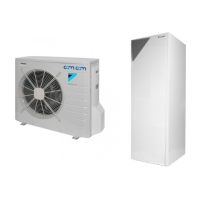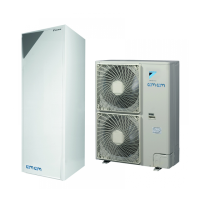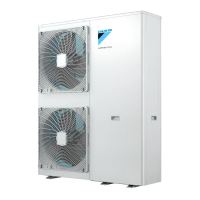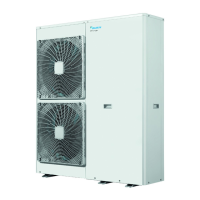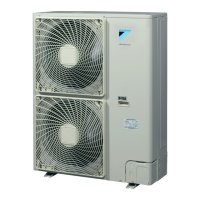5 Application guidelines
Installer reference guide
15
ERGA04~08DAV3(A) + EHVH04+08S23DAV
Daikin Altherma – Low temperature split
4P499573-1 – 2017.12
▪ The user interface connected to the indoor unit decides the space
operation mode. Mind that the operation mode on each remote
controller of the heatpump convectors must be set to match the
indoor unit.
Configuration
Setting Value
Unit temperature control:
▪ #: [2.9]
▪ Code: [C-07]
2 (Room thermostat): Unit
operation is decided based on
the ambient temperature of the
user interface.
Note:
▪ Main room = user interface
used as room thermostat
functionality
▪ Other rooms = external room
thermostat functionality
Number of water temperature
zones:
▪ #: [4.4]
▪ Code: [7-02]
1 (Dual zone): Main + additional
In case of heatpump convectors:
External room thermostat for the
additional zone:
▪ #: [3.A]
▪ Code: [C-06]
1 (1 contact): When the used
external room thermostat or
heatpump convector can only
send a thermo ON/OFF
condition.
Shut-off valve output Set to follow the thermo demand
of the main zone.
At the mixing valve station Set the desired main leaving
water temperature.
Benefits
▪ Comfort.
▪ The smart room thermostat functionality can decrease or
increase the desired leaving water temperature based on the
actual room temperature (modulation).
▪ The combination of the two heat emitter systems provides the
excellent heating comfort of the under floor heating, and the
rapid air heat up of the heat pump convectors (e.g., living
room=under floor heating and the bedroom=convector (no
continuous heating)).
▪ Efficiency.
▪ Depending on the demand, the indoor unit supplies different
leaving water temperature matching the design temperature of
the different heat emitters.
▪ Underfloor heating has the best performance with Altherma LT.
5.3 Setting up an auxiliary heat source
for space heating
▪ Space heating can be done by:
▪ The indoor unit
▪ An auxiliary boiler (field supply) connected to the system
▪ When the room thermostat requests heating, the indoor unit or the
auxiliary boiler starts operating depending on the outdoor
temperature (status of the changeover to external heat source).
When the permission is given to the auxiliary boiler, the space
heating by the indoor unit is turned OFF.
▪ Bivalent operation is only possible for space heating, NOT for
domestic hot water production. Domestic hot water is always
produced by the DHW tank connected to the indoor unit.
INFORMATION
▪ During heating operation of the heat pump, the
heat pump operates to achieve the desired
temperature set via the user interface. When weather-
dependent operation is active, the water temperature is
determined automatically depending on the outdoor
temperature.
▪ During heating operation of the auxiliary boiler, the
auxiliary boiler operates to achieve the desired water
temperature set via the auxiliary boiler controller.
Setup
▪ Integrate the auxiliary boiler as follows:
a b c e f
f
g h j
FHL1
FHL2
FHL3
M
h
i
il
k
m
n
d
a Outdoor unit
b Indoor unit
c Heat exchanger
d Anti-legionella heater
e Pump
f Shut-off valve
g Motorised 3‑way valve
h Non-return valve (field supply)
i Shut-off valve (field supply)
j Collector (field supply)
k Auxiliary boiler (field supply)
l Aquastat valve (field supply)
m DHW tank
n Heat exchanger coil
FHL1...3 Underfloor heating
NOTICE
▪ Make sure the auxiliary boiler and its integration in the
system complies with applicable legislation.
▪ Daikin is NOT responsible for incorrect or unsafe
situations in the auxiliary boiler system.
▪ Make sure the return water to the heat pump does NOT exceed
55°C. To do so:
▪ Set the desired water temperature via the auxiliary boiler
controller to maximum 55°C.
▪ Install an aquastat valve in the return water flow of the
heatpump.
▪ Set the aquastat valve to close above 55°C and to open below
55°C.
▪ Install non-return valves.
▪ Make sure to only have one expansion vessel in the water circuit.
An expansion vessel is already pre-mounted in the indoor unit.
▪ Install the digital I/O PCB (option EKRP1HB).
Final English - Tanslations in progress

